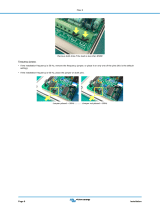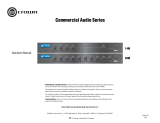
Direct Out to Gated Direct Out
This post-fader, post-EQ channel output is gated, but without NOMA. In this
mode, if the Local/Global switch is in “Local”, a manual mix of channel inputs
is present at the Line output. The Off-Attenuation level of the Gated Direct
Out signal is infinite.
Procedure:
Short jumpers X104 and X906 (in Master section). Remove resistor R1011.
SCM810 Speech Gate for Mixing Console
The SCM810 can be used in conjunction with large mixing consoles to provide
automatic mixing for talk shows, panel discussions, and news shows. Large
consoles have channel insert jacks so that external signal processing devices
can be patched into individual channel signal paths. With this modification
the SCM810 can be placed into unbalanced insert jacks, and the SCM810
used as a high-quality, external, 8-channel speech gate. This arrangement
allows the operator complete control of each channel via the console's input
control strip, while the SCM810 keeps the number of open microphones to
a minimum.
In this operational mode:
1. The Direct Out jack tip is the input from the mixing console, and the ring
is the output to the mixing console.
2. The SCM810 channel inputs, faders and EQ do not function.
3. NOMA does not function, channel Off-Attenuation is infinite.
4. The front-panel channel overload indicators indicate gating and overload
for each input.
5. The “Local” operating mode provides a non-automatic audio signal at
the output for use in external mixes.
6. If the insert point on the mixing console is pre-fader, the gain trims should
be set such that all microphone levels are similar.
Procedure:
Short jumpers X103, X107, X108 and X906 (in the Master section). Remove
resistors R1011, R1019, and R1020.
MUTE IN Precedence to OVERRIDE IN Precedence
With this modification and when both MUTE IN and OVERRIDE IN logic are
grounded for a channel, the Override mode will take precedence (as supplied,
the MUTE IN takes precedence over OVERRIDE IN).
Procedure:
Short jumper X114. Remove resistor R1046.
Dead Zone on MUTE IN Defeat
As supplied, MUTE IN is intended for use as a momentary cough button or
privacy function (mute when necessary). However, if the MUTE IN is intended
to be used so that the talker must unmute microphones to enable speech
pickup (unmute when needed), this modification is needed. This removes
the muted channel from the MaxBus which eliminates “dead zones.” A dead
zone is an area in which a microphone picks up a talker through a muted
microphone and other microphones do not activate for that talker.
Procedure:
Short jumper X115.
Change MUTE IN to Inhibit
As supplied, a channel will mute when its MUTE IN terminal is grounded.
The mute function can be changed to “Inhibit” by an internal modification for
each channel. After the modification, a logic “Low” at the MUTE IN terminal
prevents that channel from gating on if it is off, but allows it to remain on if it
is already on. IMPORTANT: To prevent high-frequency oscillation, never
connect a channel's GATE OUT to its own MUTE IN unless the “Inhibit”
modification has been made.
Procedure:
Short jumper X111..
Change OVERRIDE IN to MUTE IN for Use with Fili-
buster Mode
This modification should only be performed with the Change MUTE IN to In-
hibit modification described above.
Procedure:
Short jumper X113. Remove resistors R1046 and R1058.
Change Off-Attenuation Level
This modification changes the off-attenuation level from -15 dB to a selected
value. Select from the following resistor values.
ResistanceMaster Section Gain
18 kΩ10 dB
50 kΩ20 dB
150 kΩ30 dB
Procedure:
Remove resistors R9088 and R9145. Install new resistor at jumper points
X904 and X908.
Increase Hold Time
In addition to the dip switch SW702 options of 0.4- and 1.0-second hold time,
the hold time can be increased to 1.5 seconds. (More than 1.5 seconds is
not recommended.)
Procedure:
Install a 470 kΩ resistor across jumper points X902. Move DIP switch down
to 1.0-second position.
Decrease Hold Time
The hold time can be decreased from the factory preset of 0.4 seconds to
0.3 seconds. (Less than 0.3 seconds is not recommended.)
Procedure:
Install a 2 MΩ resistor at jumpers X903.
Remote Control of Link Global/Local, Off-Attenua-
tion, Last Mic Lock-on, and Automatic/Manual DIP
Switches
If desired, these functions can each be remotely controlled with an SPST
switch.
Procedure:
1. Solder a wire in the pc board jumper hole adjacent to the desired function
(printed on the printed circuit board). These jumpers are located just
behind DIP switch SW902.
2. Solder a wire in the pc board jumper hole marked “GND” near switch
SW902.
3. Set the desired DIP switch(es) to the Up position.
4. Run the jumper wires to the desired remote location and solder them to
an SPST toggle switch. The wires can exit the SCM810 chassis above
the DIP switches. Shorting any wire to the Ground wire will set the func-
tion(s) to the corresponding switch “down” position.
Shure IncorporatedSCM810 Eight-Channel Microphone Mixer
13/13
Shure Incorporated 5800 W
est T
ouhy A
ven
ue Niles, IL 60714-4608 USA Phone: +1-847-600-2000 Email:
[email protected]














